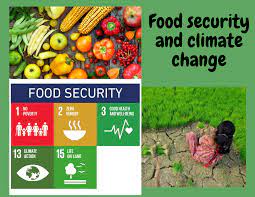Food security and climate change are deeply interconnected issues that pose significant challenges to global sustainability and human well-being.
- IMPACT ON AGRICULTURE: Climate change affects agricultural productivity through changes in temperature, precipitation patterns, and extreme weather events. Heatwaves, droughts, floods, and storms can damage crops, reduce yields, and disrupt food supply chains.
- SHIFTS IN GROWING CONDITIONS: Climate change alters the suitability of land for different crops, leading to shifts in growing conditions. Some regions may experience benefits, such as longer growing seasons or increased rainfall, while others face decreased productivity or even crop failures.
- RISING FOOD PRICES: Climate-related disruptions in food production can lead to price volatility and increased food prices, impacting vulnerable populations’ access to nutritious food.
- EXTREME EVENTS: Extreme weather events linked to climate change, such as hurricanes, floods, and wildfires, can destroy crops, livestock, and infrastructure, leading to food shortages and humanitarian crises.
- ADAPTATION CHALLENGES: Farmers and food systems must adapt to changing climate conditions, requiring investments in resilient agricultural practices, improved infrastructure, and access to climate information and technologies.
- FOOD DISTRIBUTION AND TRADE: Climate change can disrupt food distribution networks and international trade routes, affecting food access and availability globally. Vulnerable regions may become increasingly reliant on food imports, heightening food security risks.
- NUTRITIONAL IMPACTS: Changes in agricultural productivity and food availability can affect dietary diversity and nutritional quality, potentially exacerbating malnutrition and related health problems.
- POLICY RESPONSES: Addressing the complex interplay between food security and climate change requires coordinated efforts at local, national, and international levels. Strategies may include promoting sustainable agriculture, investing in climate-resilient infrastructure, improving social safety nets, and mitigating greenhouse gas emissions to limit further climate change impacts. Food security in the context of climate change requires comprehensive approaches that consider the interdependencies between agriculture, the environment, and socio-economic factors, with a focus on building resilience and ensuring equitable access to food resources for all populations.
Food security is crucial for several reasons:
- BASIC HUMAN NEED: Food is a fundamental human need. Access to an adequate, nutritious diet is essential for maintaining health, supporting growth and development, and ensuring overall well-being.
- POVERTY ALLEVIATION: Food security plays a central role in poverty alleviation efforts. Without access to sufficient and nutritious food, individuals and communities cannot break out of the cycle of poverty.
- HEALTH AND NUTRITION: Adequate food security is essential for good health and nutrition. Malnutrition, including both undernutrition and overnutrition, can have severe consequences for physical and mental health, as well as cognitive development, particularly in children.
- ECONOMIC STABILITY: Food security contributes to economic stability at both the individual and national levels. Access to sufficient food enables people to engage in productive activities, pursue education and training, and contribute to economic growth.
- SOCIAL STABILITY: Food security is closely linked to social stability and resilience. Inadequate access to food can lead to social unrest, conflict, and migration as communities struggle to meet their basic needs.
- ENVIRONMENTAL SUSTAINABILITY: Achieving food security in a sustainable manner is essential for preserving natural resources and mitigating environmental degradation. Sustainable agricultural practices can help protect soil health, conserve water, and reduce greenhouse gas emissions.
- RESILIENCE TO SHOCKS: Food security promotes resilience to shocks and stresses, including natural disasters, economic downturns, and conflicts. Communities with strong food systems are better equipped to withstand and recover from crises.
- HUMAN RIGHTS: Food security is recognized as a basic human right. The right to food implies that every person should have physical and economic access to sufficient, safe, and nutritious food to meet their dietary needs and preferences.
- GLOBAL STABILITY: Ensuring food security is essential for global stability and peace. Addressing food insecurity can help prevent conflicts over scarce resources and promote cooperation among nations to address common challenges.
- SUSTAINABLE DEVELOPMENT GOALS: Food security is integral to achieving several Sustainable Development Goals (SDGs), including those related to poverty eradication, zero hunger, good health and well-being, quality education, gender equality, and climate action. In summary, food security is not only a matter of fulfilling basic needs but also a critical component of sustainable development, human rights, and global stability.
Achieving food security in India requires a multi-dimensional approach that addresses challenges related to production, distribution, and nutrition while leveraging the country’s agricultural potential, technological advancements, and policy initiatives. Efforts should focus on promoting sustainable and climate-resilient agriculture, enhancing market access and infrastructure, and addressing socio-economic inequalities to ensure equitable food access for all segments of the population.
India faces both challenges and opportunities in achieving food security: A. CHALLENGES:
POPULATION PRESSURE: India has a large and growing population, putting immense pressure on food resources. Climate Vulnerability: The country is highly vulnerable to climate change, with erratic rainfall patterns, extreme weather events, and increasing temperatures affecting agricultural productivity. Water Scarcity: Many regions in India face water scarcity, impacting irrigation and agricultural production.
LAND DEGRADATION: Soil erosion, depletion of nutrients, and urbanization contribute to land degradation, reducing agricultural productivity.
FOOD DISTRIBUTION: Despite adequate food production, challenges in distribution and logistics result in food insecurity for certain populations, particularly in remote or marginalized areas. Malnutrition: India continues to grapple with high levels of malnutrition, including both undernutrition and overnutrition, leading to health issues and hindering human development.
B. OPPORTUNITIES:
DIVERSE AGRICULTURAL POTENTIAL: India has diverse agro-climatic zones, allowing for the cultivation of a wide variety of crops, including cereals, fruits, vegetables, and spices.
TECHNOLOGICAL ADVANCEMENTS: The country has made significant strides in agricultural research and technology adoption, including the use of high-yielding crop varieties, precision farming techniques, and mechanization.
GOVERNMENT INITIATIVES: Various government initiatives, such as the National Food Security Mission, Pradhan Mantri Krishi Sinchayee Yojana (PMKSY), and Rashtriya Krishi Vikas Yojana (RKVY), aim to enhance agricultural productivity, improve water management, and promote sustainable farming practices.
MARKET REFORMS: Recent agricultural reforms, such as the introduction of electronic trading platforms and contract farming laws, have the potential to modernize the agricultural sector, improve market access for farmers, and increase income opportunities.
CLIMATE ADAPTATION: Investments in climate-resilient agriculture, including drought-tolerant crops, water-efficient irrigation systems, and climate-smart farming practices, can help mitigate the impacts of climate change on food production.
NUTRITION PROGRAMS: Government schemes like the Integrated Child Development Services (ICDS) and the National Nutrition Mission (Poshan Abhiyan) aim to address malnutrition by improving maternal and child health, promoting breastfeeding, and providing nutritious food supplements.
PARTNERSHIPS AND COLLABORATION: Collaboration between government agencies, research institutions, NGOs, and the private sector can foster innovation, knowledge sharing, and capacity building in the agriculture and food sectors. Achieving food security in India requires a multi-dimensional approach that addresses challenges related to production, distribution, and nutrition while leveraging the country’s agricultural potential, technological advancements, and policy initiatives. Efforts should focus on promoting sustainable and climate-resilient agriculture, enhancing market access and infrastructure, and addressing socio-economic inequalities to ensure equitable food access for all segments of the population.























